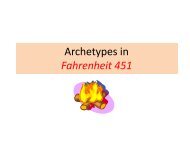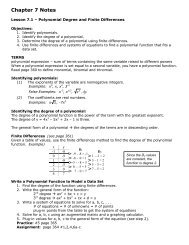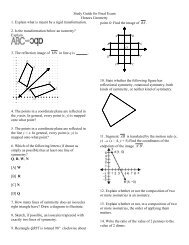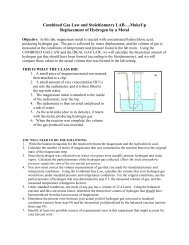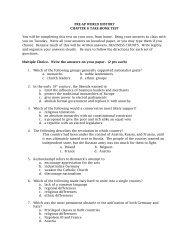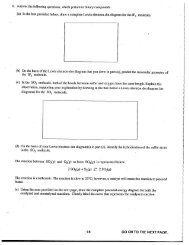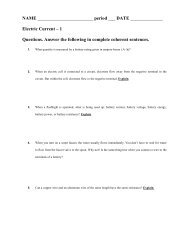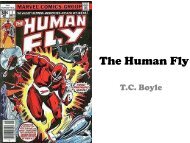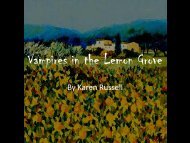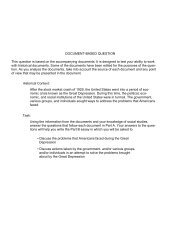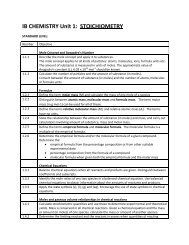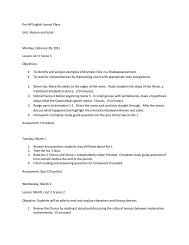The Prologue to The Canterbury Tales
The Prologue to The Canterbury Tales
The Prologue to The Canterbury Tales
Create successful ePaper yourself
Turn your PDF publications into a flip-book with our unique Google optimized e-Paper software.
<strong>The</strong> <strong>Prologue</strong> <strong>to</strong> <strong>The</strong> <strong>Canterbury</strong> <strong>Tales</strong><br />
by Geoffrey Chaucer<br />
Feature Menu<br />
Introducing the Selection<br />
Literary Focus: Characterization<br />
Literary Focus: Frame S<strong>to</strong>ry<br />
Reading Skills: Analyzing Style:<br />
Key Details
<strong>The</strong> <strong>Prologue</strong> <strong>to</strong> <strong>The</strong> <strong>Canterbury</strong> <strong>Tales</strong><br />
by Geoffrey Chaucer<br />
Chaucer’s <strong>Canterbury</strong> Pilgrims (1810) by William Blake. Engraving.
<strong>The</strong> <strong>Prologue</strong> <strong>to</strong> <strong>The</strong> <strong>Canterbury</strong> <strong>Tales</strong><br />
by Geoffrey Chaucer<br />
For the most part, only the light characters<br />
travel. Who are you that have no task <strong>to</strong><br />
keep you at home?<br />
—Ralph Waldo Emerson (1803–1882)
<strong>The</strong> <strong>Prologue</strong> <strong>to</strong> <strong>The</strong> <strong>Canterbury</strong> <strong>Tales</strong><br />
by Geoffrey Chaucer<br />
Take a Tour<br />
If you went on a <strong>to</strong>ur<br />
<strong>to</strong>day, what types of<br />
people would you meet?<br />
Do you think you might<br />
come across a “character”<br />
or two?<br />
Chaucer’s characters are the kinds of people he<br />
would have known in real life and observed riding<br />
<strong>to</strong>ward <strong>Canterbury</strong> on the old pilgrimage road.
<strong>The</strong> <strong>Prologue</strong> <strong>to</strong> <strong>The</strong> <strong>Canterbury</strong> <strong>Tales</strong><br />
by Geoffrey Chaucer<br />
Chaucer used the East Midland dialect of Middle<br />
English. This dialect was the most common<br />
colloquial language at the time and became the<br />
basis for modern English.
<strong>The</strong> <strong>Prologue</strong> <strong>to</strong> <strong>The</strong> <strong>Canterbury</strong> <strong>Tales</strong><br />
by Geoffrey Chaucer<br />
Twenty-nine pilgrims are on their way <strong>to</strong> the shrine<br />
of Saint Thomas à Becket in <strong>Canterbury</strong>.<br />
<strong>The</strong> time is April, and the<br />
place is the Tabard Inn in<br />
Southwark (SUTH erk), just<br />
outside London.<br />
London<br />
<strong>Canterbury</strong><br />
[End of Section]
<strong>The</strong> <strong>Prologue</strong> <strong>to</strong> <strong>The</strong> <strong>Canterbury</strong> <strong>Tales</strong><br />
Literary Focus: Characterization<br />
Chaucer uses indirect characterization when he<br />
tells how each character<br />
• looks and dresses<br />
This yeoman wore a coat and hood of green,<br />
And peacock-feathered arrows, bright and keen<br />
• speaks and acts<br />
Her greatest oath was only “By St. Loy!”<br />
• thinks and feels<br />
And gladly would he learn, and gladly teach.
<strong>The</strong> <strong>Prologue</strong> <strong>to</strong> <strong>The</strong> <strong>Canterbury</strong> <strong>Tales</strong><br />
Literary Focus: Characterization<br />
Chaucer also uses direct characterization, when<br />
he comes right out and tells us what a character’s<br />
nature is—virtuous, vain, clever, and so on.<br />
<strong>The</strong>re was a Friar, a wan<strong>to</strong>n one and merry,<br />
A Limiter, a very festive fellow.<br />
In all Four Orders there was none so mellow,<br />
So glib with gallant phrase and well-turned speech.<br />
[End of Section]
<strong>The</strong> <strong>Prologue</strong> <strong>to</strong> <strong>The</strong> <strong>Canterbury</strong> <strong>Tales</strong><br />
Literary Focus: Frame S<strong>to</strong>ry<br />
A frame s<strong>to</strong>ry is a literary device that binds<br />
<strong>to</strong>gether several different narratives. It is a s<strong>to</strong>ry<br />
(or s<strong>to</strong>ries) within a s<strong>to</strong>ry.<br />
• In <strong>The</strong> <strong>Canterbury</strong> <strong>Tales</strong>,<br />
the pilgrims’ journey is<br />
the outer s<strong>to</strong>ry.<br />
• <strong>The</strong> tales the pilgrims tell<br />
are s<strong>to</strong>ries within a s<strong>to</strong>ry.<br />
• <strong>The</strong> tales themselves also<br />
have thematic unity.<br />
[End of Section]
<strong>The</strong> <strong>Prologue</strong> <strong>to</strong> <strong>The</strong> <strong>Canterbury</strong> <strong>Tales</strong><br />
Reading Skills: Analyzing Style: Key Details<br />
Chaucer had twenty-nine characters <strong>to</strong><br />
introduce, so he couldn’t develop any one character<br />
at great length. Instead, he provided a few wellchosen<br />
details that would make each character<br />
stand out vividly.
<strong>The</strong> <strong>Prologue</strong> <strong>to</strong> <strong>The</strong> <strong>Canterbury</strong> <strong>Tales</strong><br />
Reading Skills: Analyzing Style: Key Details<br />
As you read the <strong>Prologue</strong>, pay close attention<br />
<strong>to</strong> any details that help give you an immediate<br />
impression of a character.<br />
• Keep a pen and notebook handy <strong>to</strong> jot down<br />
key details of dress, appearance, and<br />
behavior.<br />
• Note that some details contradict what the<br />
characters think of themselves (or want others<br />
<strong>to</strong> think of them).<br />
[End of Section]



